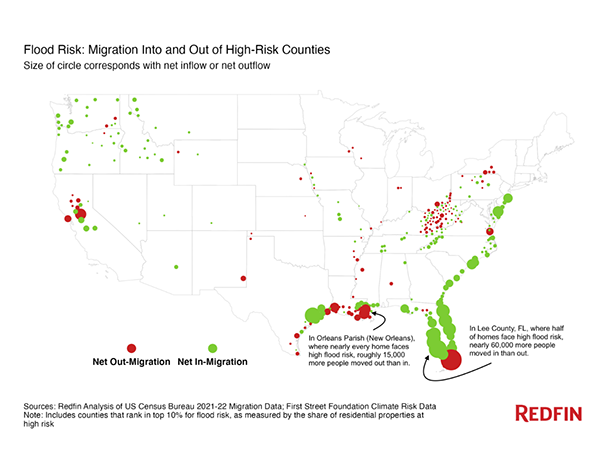
Redfin Reports Migration Into Flood-Prone Areas Has More Than Doubled Since 2020

(Courtesy Redfin, Seattle.)
The most flood-prone U.S. counties saw 384,000 more people move in than out in 2021 and 2022—a 103% increase from the prior two years, reported Redfin, Seattle.
The same trend took hold in the places most vulnerable to wildfires and heat as the pandemic homebuying boom and a housing affordability crisis pushed Americans into disaster-prone areas, Redfin said. The counties with the highest wildfire risk saw 446,000 more people move in than out over the past two years, a 51% increase from 2019 and 2020. And the counties with the highest heat risk saw 629,000 more people move in than out, a 17% uptick.
“It’s human nature to focus on current benefits, like waterfront views or a low cost of living, over costs that could rack up in the long run, like property damage or a decrease in property value,” said Redfin Chief Economist Daryl Fairweather. “It’s also human nature to discount risks that are tough to measure, like climate change.”
Redfin analyzed domestic migration data from the U.S. Census Bureau and climate-risk scores from First Street Foundation.
The Mortgage Bankers Association recently released Disaster Recovery: A Resource for Homeowners, a resource paper for homeowners that outlines what to do before and after the disaster along with how to start, and then work through the recovery process.
Remote work and record-low mortgage rates during the pandemic prompted scores of Americans to leave expensive coastal cities such as San Francisco and New York for the Sun Belt in search of more affordable housing, warm weather and/or lower taxes. States including Florida, Texas and Arizona exploded in popularity despite increasing risk from storms, drought, wildfires and extreme heat.
Many disaster-prone areas are relatively affordable because homebuyers and renters have a larger pool of homes to choose from, Redfin noted. America is increasingly building housing in places endangered by climate change; more than half of homes built so far this decade face fire risk, while 45% face drought risk, a separate Redfin analysis found. By comparison, just 14% of homes built from 1900 to 1959 face fire risk and 37% face drought risk. New homes are also more likely than older homes to face heat and flood risk.
“The consequences of climate change haven’t fully sunk in for many Americans because oftentimes, homeowners and renters don’t foot the whole bill when disaster strikes,” Fairweather said. “Insurers and government programs frequently subsidize the cost of rebuilding after storms hit, and mortgages mean homeowners are ceding some risk to lenders—especially if their house goes into foreclosure after a storm. But with natural disasters intensifying and insurers pulling out of disaster-prone areas including Florida and California, Americans may start feeling a greater sense of urgency to mitigate climate dangers—especially if their home’s value is at risk of declining.”
